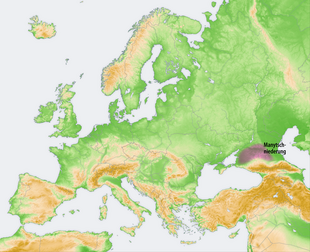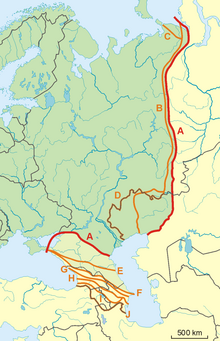Manytn lowlands
The Manytschniederung (also Kuma- Manych -Niederung ; Russian Кумо-Манычская впадина , Kuma- Manych -Senke ) is an approximately 500-kilometer-long depression between the Kuban-Azov depression and the Caspian depression in southern Russia . Together with the Caspian Depression, the lowland forms the southeastern boundary of the Eastern European Plain .
Location and geology
The lowland extends between the lower reaches of the Don and the northwestern part of the Caspian Depression. The actual lowland is only 20 to 30 kilometers wide, in the central part only 1 to 2 kilometers. It separates the Jergeni hills to the north from the Stavropol mountain range , which gradually rises to the south and is part of the foothills of the Greater Caucasus .
The lowland is named after the river Manych flowing through it and the lake system of the same name . In some cases, the eastern extension of the lowland towards the Caspian Depression or the Terek-Kuma Lowland , which is traversed by the lower Kuma , is counted as a lowland. This explains the alternative name commonly used in Russia, literally “Kuma-Manytsch-Senke”, since this eastern part fulfills the criterion of surface height below sea level necessary for a sink in the geomorphological sense . The highest point of the lowland is 27 m above sea level ( location ), in a north-westerly and south-easterly direction it drops to just above sea level, in the south-east, depending on the demarcation, it sinks just below it.
The Manytn lowland lies on the territory of Rostov Oblast , forms the border between the Stavropol region and the Republic of Kalmykia for long stretches and reaches the Republic of Dagestan in the east .
The lowland is of tectonic origin. It lies in the area of a depression in the earth's crust, which is accompanied by a fault zone , marks the southern edge of the "old" Russian tablet and separates it from the northern foothills of the Caucasus, which geologically already belongs to the young, Alpine folds of the Caucasus. Until the Quaternary , the Black and Azov Sea and the Caspian Sea were repeatedly connected in the area of today's Manytn lowlands, interrupted by periods of low water levels in the Caspian Sea. The last time there was a connection was during the so-called (early) Chwalynsk Transgression of the Caspian Sea, which ended 10,000 years ago at the latest.
The Manytn lowlands as part of the European border
Since Philip Johan von Strahlberg's publication in 1730, the Manytn lowlands in Russia and in German-speaking countries have mostly been viewed as part of the geographical border between the two continents of Europe and Asia on the section between the Caspian and Azov Seas. This determination is based, among other things, on the fact that there was once a connection between the Caspian and the Azov or Black Seas at the location of the Manytn lowlands. However, there are no internationally binding stipulations among geographers about the course of the border between the continents, so that in some cases the main ridge of the Greater Caucasus is also seen as the border on this section, especially in the English- and French-speaking countries. According to this view, the entire Manytn lowlands would be in Europe.
Hydrography
The major part of the axis of the Manytsch lowlands is traversed by the two components of the eponymous Manych. Before the human interventions of the 20th century, most of the water of the Kalau , which comes from the Stavropol mountain range, reaches the valley at its highest point, where it formed a bifurcation , flowed as the Eastern Manych towards the Caspian Sea. As it does today, it did not reach the Caspian Sea, but got lost between smaller salt lakes in a semi-desert area almost 100 kilometers off the coast. The smaller part of the water of the Kalau flowed as the Western Manych (or simply Manych ) in a westerly direction to the Don, but took in a larger number and more water-rich tributaries than the Eastern Manych, including the (Great) Jegorlyk . He crossed several lakes, which were salty and very shallow to different degrees: the Manych-Gudilo (also Large Manychsee , Bolshoi Manych , Gudilo ), 344 km² at an average water level , the Small Manych Lake ( Maly Manych , also simply Manych ; 78.8 km²) and a further 10.7 km², also Manytsch See above.
In the 1930s, several reservoirs were built on the Western Manych, which form a closed chain practically over the entire course of the river: Ust-Manychskoje near the mouth, Vessjolowskoje, and Proletarskoye near Proletarsk . The latter is the largest of the reservoirs that also united the former Manych lakes and raised their water level by a few meters. The Tschograiskoje reservoir was completed on the Eastern Manych in 1969, and at the same time the water supply from the Kalau to the river was cut off by the construction of a dam. Since then, the Eastern Manych has mainly been fed by its former tributary Chograi and the Kuma-Manych Canal, which was built until 1965 . Below the reservoir, it releases a significant part of the water via the Chograi Canal back towards the lower reaches of the Kuma for irrigation of the areas in between.
natural reserve
According to the Ramsar Convention , the Manytn lowlands as a wetland are one of the most ornithological areas in Russia. There are two protected areas as sapowednik :
- Chornyje Semli Biosphere Reserve (since June 11, 1990): the western, 27,600 hectare sub-area includes the (former) Lake Manych-Gudilo
- Rostowski-Sapowednik (since December 27, 1995): one of the four sub-areas lies in the west of the Manych-Gudilo area
Individual evidence
- ↑ Article Kuma-Manytsch-Niederung in the Great Soviet Encyclopedia (BSE) , 3rd edition 1969–1978 (Russian)
- ↑ Soviet topographic map 1: 200,000, sheet L-38-XXI
- ↑ a b c A. Miščenko (ed.): Vodno-bolotnye ugod ʹ ja Rossii. Tom 6. Vodno-bolotnye ugod ʹ yes Severnogo Kavkaza . Wetlands International, Moscow 2006, ISBN 978-90-5882-028-0 ( Wetlands of Russia. Vol. 6. Wetlands of the North Caucasus ; Russian, online (PDF; 8.1 MB)).
- ↑ Philipp Johann von Strahlberg : The northern and eastern parts of Europe and Asia, in so far as this includes the whole Russian Empire with Siberia and the great Tatars . Stockholm 1730 ( online ).
- ↑ Brockhaus Encyclopedia, 21st edition. FABrockhaus. Leipzig / Mannheim 2006. Article Europe: "Since the 18th century, the Urals have been the borders of Europe with Asia ... Conventional borders with Asia are also formed by the Ural River, the Caspian Sea, the Manytn lowlands, the Black Sea, the Bosporus, the Sea of Marmara, the Dardanelles and the Aegean Sea " .
- ↑ Article Manytsch-Gudilo in the Great Soviet Encyclopedia (BSE) , 3rd edition 1969–1978 (Russian)
- ↑ Aleksandr Bazeljuk: Antropogennoe izmenenie gidrografičeskoj seti Kumo-Manyčskoj vpadiny . Dissertation. Southern Federal University, Rostov-on-Don 2007 ( anthropogenic change in the hydrographic network of the Kuma-Manych depression ; Russian, theses online ).
- ↑ Tschornyje Semli in the information and information system Specially Protected Natural Areas of Russia of the Center for Nature Conservation (Russian)
- ↑ Rostowski-Sapowednik in the information and information system Specially Protected Natural Areas of Russia of the Center for Nature Conservation (Russian)
Coordinates: 46 ° 22 ' N , 42 ° 43' E

